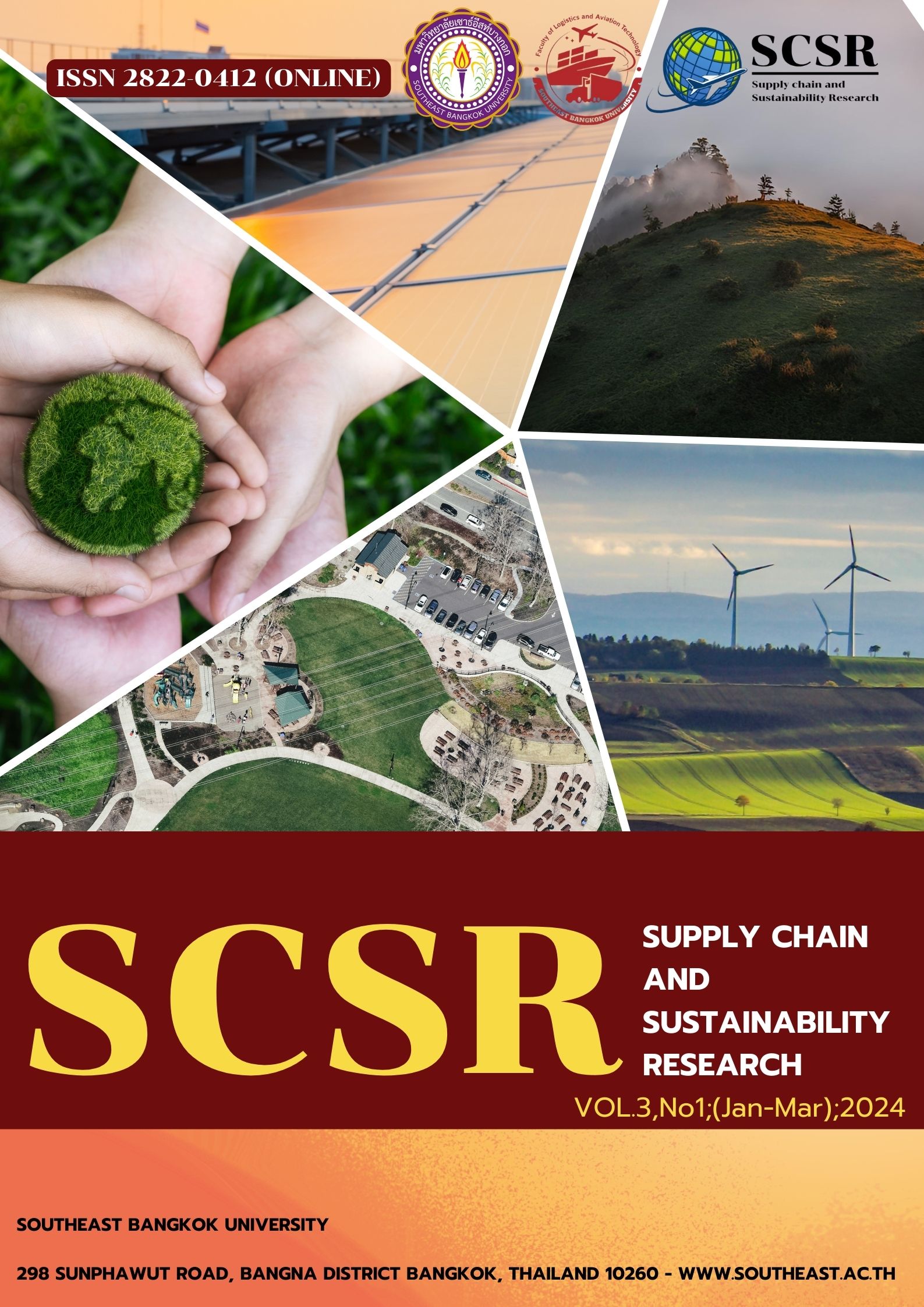Hydrogen Energy Supply Chain: Production, Storage, and Applications – An Exploratory Study
Main Article Content
บทคัดย่อ
This study explores the role of hydrogen as a clean and efficient secondary energy source in the global energy transition. Hydrogen has gained significant attention in energy research due to its zero carbon emissions, high heat value, safety features, and versatile applications. The research aims to comprehensively understand the role and impact of hydrogen in future energy systems. Through current survey methods and data analysis, the study elucidates trends in hydrogen technology development, the influence of policies and regulations, and its position in the global energy transition. The technological evolution of the hydrogen supply chain, including green hydrogen, blue hydrogen, hydrogen storage, and transportation, is highlighted. Government support, especially driven by Taiwan's hydrogen development goals and related regulations, has accelerated the growth of the hydrogen industry. In the global energy transition, hydrogen emerges as a key factor in achieving goals due to its zero emissions, diverse applications, and advantages in energy storage. However, hydrogen still faces challenges in technology and cost. Therefore, future research is recommended to focus on addressing technical bottlenecks in hydrogen production, storage, transportation, and applications, while enhancing international cooperation and technological innovation. Additionally, further understanding of the practical impact of government policies on the hydrogen industry is essential to promote its broader application in the global energy system.
Article Details

อนุญาตภายใต้เงื่อนไข Creative Commons Attribution-NonCommercial-NoDerivatives 4.0 International License.
บทความนี้ได้รับการเผยแพร่ภายใต้สัญญาอนุญาต Creative Commons Attribution-NonCommercial-NoDerivatives 4.0 International (CC BY-NC-ND 4.0) ซึ่งอนุญาตให้ผู้อื่นสามารถแชร์บทความได้โดยให้เครดิตผู้เขียนและห้ามนำไปใช้เพื่อการค้าหรือดัดแปลง หากต้องการใช้งานซ้ำในลักษณะอื่น ๆ หรือการเผยแพร่ซ้ำ จำเป็นต้องได้รับอนุญาตจากวารสารเอกสารอ้างอิง
Amin, M., Shah, H. H., Fareed, A. G., Khan, W. U., Chung, E., Zia, A., ... & Lee, C. (2022). Hydrogen production through renewable and non-renewable energy processes and their impact on climate change. International journal of hydrogen energy, 47(77), 33112-33134.
Apak, S., Atay, E., & Tuncer, G. (2017). Renewable hydrogen energy and energy efficiency in Turkey in the 21st century. International Journal of Hydrogen Energy, 42(4), 2446-2452.
Aziz, M. (2021). Liquid hydrogen: A review on liquefaction, storage, Transportation, and Safety. Energies, 14(18), 5917.
Barthélémy, H., Weber, M., & Barbier, F. (2017). Hydrogen storage: Recent improvements and industrial perspectives. International Journal of Hydrogen Energy, 42(11), 7254-7262.
Caineng, Z. O. U., Xiong, B., Huaqing, X. U. E., Zheng, D., Zhixin, G. E., Ying, W. A. N. G., & Songtao, W. (2021). The role of new energy in carbon neutral. Petroleum exploration and development, 48(2), 480-491.
DiLisi, G. A. (2017). The Hindenburg disaster: Combining physics and history in the laboratory. The Physics Teacher, 55(5), 268-273.
Kapdan, I. K., & Kargi, F. (2006). Bio-hydrogen production from waste materials. Enzyme and microbial technology, 38(5),
-582.
Kim, H., Hartmann, N., Zeller, M., Luise, R., & Soylu, T. (2021). Comparative tco analysis of battery electric and hydrogen fuel cell buses for public transport system in small to midsize cities. Energies, 14(14), 4384.
Lee, D. H., Hsu, S. S., Tso, C. T., Su, A., & Lee, D. J. (2009). An economy-wide analysis of hydrogen economy in Taiwan. Renewable Energy, 34(8), 1947-1954.
Li, Z., Wang, W., Ye, M., & Liang, X. (2021). The impact of hydrogen refueling station subsidy strategy on China's hydrogen fuel cell vehicle market diffusion. International Journal of Hydrogen Energy, 46(35), 18453-18465
Lucia, U. (2014). Overview on fuel cells. Renewable and Sustainable Energy Reviews, 30, 164-169.
Lulianelli, A., & Basile, A. (Eds.). (2014). Advances in hydrogen production, storage and distribution. Elsevier.
Moradi, R., & Groth, K. M. (2019). Hydrogen storage and delivery: Review of the state-of-the-art technologies and risk and reliability analysis. International Journal of Hydrogen Energy, 44(23), 12254-12269.
Sandstede, G., Cairns, E. J., Bagotsky, V. S., & Wiesener, K. (2010). History of low temperature fuel cells. Handbook of Fuel Cells, 1, 145-218.
Sokolov, A., Saritas, O., & Meissner, D. (2019). Global Market Creation for Fuel Cell Electric Vehicles. Emerging Technologies for Economic Development, 131-152.
Steinberg, M., & Cheng, H. C. (1989). Modern and prospective technologies for hydrogen production from fossil fuels. International Journal of Hydrogen Energy, 14(11), 797-820.
Walker, G. (Ed.). (2008). Solid-state hydrogen storage: materials and chemistry. Elsevier.
Wang, Y., Dai, X., You, H., & Gao, M. (2018). Research on the design of hydrogen supply system of 70 MPa hydrogen storage cylinder for vehicles. International Journal of Hydrogen Energy, 43(41), 19189-19195.
West, J. B.,& Cavendish, H. (2014). Hydrogen, carbon dioxide, water, and weighing the world. American Journal of Physiology- Lung Cellular and Molecular Physiology, 307(1), L1-L6.
Witkowski, A., Rusin, A., Majkut, M., & Stolecka, K. (2017). Comprehensive analysis of hydrogen compression and pipeline transportation from thermodynamics and safety aspects. Energy, 141, 2508-2518.
Zhu, M., Ai, X., Fang, J., Wu, K., Zheng, L., Wei, L., & Wen, J. (2023). Optimal integration of electrolysis, gasification and reforming for stable hydrogen production. Energy Conversion and Management, 292, 117400.
Zhang, L., Jia, C., Bai, F., Wang, W., An, S., Zhao, K., ... & Sun, H. (2024). A comprehensive review of the promising clean energy carrier: Hydrogen production, transportation, storage, and utilization (HPTSU) technologies. Fuel, 355, 129455.


